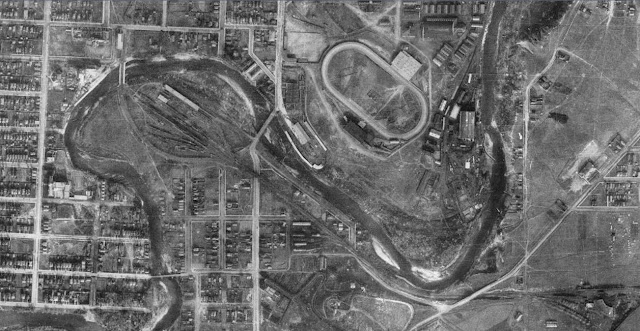Tuesday, 31 October 2017
Gnomes
And, here's me and how I greeted the kids at the door in my costume at Hallowe'en last year. Not to scare the little ones, but certainly enough to get them thinking a bit! haha
Wednesday On Tuesday
Remember the creepy little girl Wednesday Addams, from the 1991 movie "The Addams Family"? Here's my daughter, doing her rendition for Hallowe'en last year.
Gothic
Just came back from Montreal and on one of our evenings we were out wandering the streets near the Jean Talon market. It was dark and a bit stormy, threatening to rain, when we came across this cool church spire lit up with dark purple lighting. Here's an unedited copy of my photo, quite Gothic and an eerie fit with today's Hallowe'en themed posts.
Vampires
The real vampires, in the form of bats! Perhaps these little critters were some of the inspiration for Bram Stoker's "Dracula", but they have a somewhat undeserved bad rap, as their 'blood sucking' activity would likely go unnoticed on most creatures.
Check out this cool Nat Geo video that explains things in more detail.Saturday, 28 October 2017
Calgary 1924
 |
| Downtown Calgary 1924 |
After going through the election process and hearing about the multitude of issues in our city I thought it timely to post about our city back in 1924 since I've had the link to a City Of Calgary archived map from that era 93 years ago, complete with some interesting photos that show our tremendous growth. There were also some facts about the era, including some pertaining to an election.
- The Mayor at the time was George Webster and there was a total of 12 Aldermen on City council. Seems like a lot, considering the city has only 14 in 2017
- Voters needed to be 21 years of age or older and had to select aldermen based on 1st choice, 2nd choice, 3rd choice etc.
- It cost $67 to produce the 22,000 ballots used in the 1924 election
- 100 Civic employees did the official count
- For perspective, consider that a golf membership at the Shaganappi Golf Course was $10 for men and $8 for women, Model bread won the tender to supply the General Hospital with bread at ¢7 per loaf and the first ever Dominion Day celebration fireworks cost $197
Here are a few area maps showing how much has changed in 93 years. The photos are from a compilation of 138 taken from a height of 2272 m (7500 ft.) in a Vickers Viking Biplane
This area is Macleod Trail at the Elbow River, with Stampede Park on the right. Note that the racetrack is situated quite a bit further east than the present day track. There is a railway running along what is now 25 Ave. S.E., and what is now Lindsey Park and the Repsol Centre was once a rail yard.
This photo shows 16 Ave., NW. at the top, intersected by 14 St on the left and 10 St on the right. I couldn't find out just what the building and other structures are in the centre of the area that now hosts the North Hill Mall, which coincidentally was Calgary's first, built in 1958.
Macleod Tr at 42 Ave.,S.E., which seems to be the edge of town in 1924. That would be Stanley Park in the middle of the frame, with Elbow Dr on the left.
The road running horizontally through the middle of this photo is Glenmore Tr, so this photo shows the area that would eventually be the Glenmore Reservoir. Of course, Crowchild Tr will eventually run north -south on the left hand side of the frame and tie in to Glenmore.
That's Bowness Rd on the far right side of the frame, crossing over the Bow River. The Trans-Canada/16 Ave. will eventually cut through here, running parallel to the railway tracks that still exist to this day. Bowness would eventually be incorporated into a village in 1948, a town in 1951 and a part of Calgary in 1963.
This photo shows what was the village of Midnapore, way out of the Calgary city limits. Of course, a lot has changed since 1924 and the community of Midnapore is many kilometres inside the south edge of the city now.
On the far right is the town of Forest Lawn, way east of the city. Pearce Estate Park is still tucked away in that bend in the Bow.
Tuesday, 24 October 2017
Kid Care
In North America, 22% of children between the ages of 6 and 9 own or have use of a cell phone. Since this is Cyber Security Awareness Month we want to discuss the various aspects of cyber crime and the dangers posed by the personal devices being used by children and teens.
10 great tips to help you and your kids stay safe with cell phones.
-Set a password to lock the keypad and screen when the phone is not in use. 96% of missing phones had the users' information accessed.-Tape your home phone number on the back of the cell phone. 50% of finders try to find the owners of missing property.
-Preset emergency and parental contact numbers on the phone and teach your children how to access them
-Turn off geo-tagging in apps, other than the ones used for safety or phone finding.
-Review your child's school cell phone use policies
-Set limits by discussing cell phone contracts and phone plans
-Have a communal charging station in a public area of your home for the family to all use together.
-Set rules for selecting, purchasing and downloading new games and apps.
-Discuss the issues of things like cyber bullying and sexting, as well as what may happen when phones are left unguarded.
-Emphasize the dangers of clicking links or answering calls and texts from unknown sources or callers. 55% of teens admit to having given personal information to strangers, including photos and personal descriptions.
Saturday, 21 October 2017
Riding Through North Korea
Here's an interesting little video about some folks who did some adventure riding through North Korea, a rarity to say the least.
Thursday, 19 October 2017
The Secret Password

When given some basic personal information, like that found on a person's Facebook page or through their other social media, many people's passwords are totally predictable or extremely easy to figure out.
Though the average person may not be the target of malicious hackers, one never knows and I like to think that "an ounce of prevention is worth a pound of cure", as the old saying goes.Check out this graphic that shows the average time it would take a hacker to gain access to your computer or phone, based on the strength of your password.
 |
| Somewhat unsettling,as is the case with many cyber crimes |
Here are a few tips on developing strong password protocols and keeping your devices safe and secure.
- Always cover up the keypad when entering your password on any device, such as ATMs and payment machines etc. This also includes your phone, when opening the device.
- Use different passwords for different devices and accounts so unlawful access to one doesn't open the door to all the others.
- Change your passwords regularly, and more often on the more important accounts, such as banking. And do not reuse the same passwords for a least 12 months.
- The strongest passwords use a minimum of 8 characters, upper and lowercase, numbers, and symbols. Something like T@3eF8!p may be difficult to remember but extremely hard to hack as well.
- Do not tell anyone your password, including friends. Your status may change and that person may not always be a friend or companion.
- Make use of comprehensive software and keep your computer and other devices updated.
- Avoid using your passwords on computers or devices you do not control, e.g. the library or an internet cafe, as they may contain malware and other means of stealing information.
- Likewise, do not use your passwords when using unsecure WiFi, such as that at the airport or coffee shop.
Tuesday, 17 October 2017
Eye Spy
You know that no matter where you are when out in public, there's always a possibility that you could have your actions recorded, be it a CCTV security camera, someone with a Smart phone, or even a game cam of some kind. Of course, in the sanctity of your own home, you'd like to believe that you have total control of your privacy but this may not necessarily be true.
If you have an internet connected camera, you have potential for a hacker to gain control and use that device to see inside your home and 'spy' on you or your family. Sounds creepy and ominous for sure, and certainly possible if you haven't taken the necessary steps to prevent this type of cyber crime from occurring. |
| photo courtesy of Electronic Frontier Foundation |
Here are a few tips that may help you feel a bit more confident and comfortable with your computer or laptop camera.
- When using an external, plug-in type of webcam, only plug it in when using it and be sure to unplug it when done.
- Many cameras have a cover that will slide over the lens when the camera is not in use, or you can place a piece of tape or other material over the lens when not in use. just be careful not to damage the lens in the process.
- Make sure you have good software installed on your computer or laptop that includes firewalls, antivirus and anti-spyware, and other tools to lock out hackers. You can also set up your computer or get apps that tell you when the camera is being activated and have it setup to require your permission to be used. Programs like 'OverSight" and "MicroSnitch" are examples of apps that monitor your camera and microphone and let you know if someone is trying to activate these tools.
- Use only trusted and reputable computer technicians and service providers when purchasing computers and having repairs done, as this will better protect you from someone who may try to install remote access programs.
- Be sure to have strong password protocols on your WiFi set up, which is another way hackers gain access to your devices.
- If you have children you can use Parental Controls to lock out the use of the camera when they log on.
 |
| photo courtesy of Rubberman Webcam |
Tuesday, 10 October 2017
Cyber Security For The Kids and Teens
 |
| photo courtesy of The Educator |
Just like adults, children and teens are vulnerable to many types of internet scams and security issues, but compounded by the fact that they are all the more innocent and trusting.
Drive-by downloads, links to malicious sites and malware are all threats but kids are also targeted by 'fan sites' that can contain offers of 'free stuff' or have malicious links, or messages from what appears to be friends, or perhaps offers of free music, games or ring tones and other things to which kids are attracted.
Of course, there are the pedophile creeps that prey on kids and young teens, but the cyber security safety tips we'll be talking about can be a basic start to protecting kids from online threats.
Start Right from the Beginning
Of course, it's up to us adults to set the stage properly, with things like up to date operating systems and security software, as well as things like strong password protocols. The latter also applies to things like mobile devices such as Smart phones, something so many kids have these days.As a side note, please read my post titled "Not So Smart Phone!" for some important tips on securing these devices and keeping your personal information safe.
As for those strong password protocols I mentioned, there are a slew of suggestions coming up in a future post or check out the BlueCircle website for tips on this topic as well as other cyber security items.
Create Strong Passwords
In the meantime, one basic rule for kids when it comes to passwords should be to never ever share theirs with anyone, not even a friend.Friends can become ex-friends or can be careless and the more widespread a password is, the more susceptible a child or teen can become to stalkers and hackers. As for some of the vulnerabilities, consider the following...
-kids love videos, like YouTube, and there can be many malicious links hidden within, redirecting to inappropriate or illegal content. Scams can be disguised by the lure of " who's got a crush on you" and other such things with which young people may be concerned.
-kids are big fans, of sports, music groups or other types of celebrities, and can be lured to sites that falsely proclaim to be legitimate, again redirecting to malicious sites.
-kids often use the family computer and though they don't have credit cards or access financial institutions, they can open the door to hackers who can install spyware and gain information that could affect all users.
-kids' identifications are valuable to thieves who may use them to illegally obtain credit or commit a crime. Typically, if credit is illegally obtained, it's not discovered for years, such as when a child is older and may try to get a student loan for example.
-kids are social and therefor susceptible to all types of cyber bullying and threats related to their online profiles and social media accounts.
Check out the graphic posted below for a good sense of what steps should be followed by kids and teens online, in the form of a pledge that can be taken by families, together, including parents and grandparents. And really, the key to all of this is being aware and involved with your kids ( or grandchildren) and their online activities and socializing so that you can monitor what's going on and be open to discussion with them about being safe and secure. Knowing kids these days, they might even teach you a few things you didn't know as well! haha.
 |
| image courtesy of cyberaware.org |
Sunday, 8 October 2017
Strange Beasts
So, after suffering through an early dump of snow and minus temperatures on the weekend at the camp, then having to drive home in the evening on some nasty roads, I got to thinking about alternative vehicles that are meant to handle the snow and cold.
As usual, the internet never fails to amaze with the crazy array of every type of tracked beast one could imagine for Winter navigation. Check out this variety of vehicles, from the military (of course ) to home made, and everything in between, even a self propelled model.
 |
| Not sure just what this home made looking rig does but it must be serious |
 |
| Always count on the military to have seriously tracked machines |
 |
| Take an old VW Micro-Bus.... |
 |
| Back in the day..... |
 |
| Not sure if this is a working model but it looks massively impressive for a vintage machine |
 |
| This slick and sleek looking Argo would be pretty quick on snow |
 |
| Better have good balance with this self propelled rig |
 |
| I thought this Volvo rig was military but apparently this one is used in the logging industry |
 |
| The Mini-Ripsaw is evidently built a bit more nimble than most of the machines in this post |
 |
| Someone obviously lives in a place where this conversion makes total sense |
 |
| An old school touring tracked machine still used in Yellowstone National Park |
 |
| Did you read my post titled "Want", about the Sherp ATV? |
 |
| Another quick looking rig, but at least this one has the creature comforts of a closed cab |
 |
| Again, an old school conversion, so people were obviously thinking of the same thing back in those days |
 |
| Another VW conversion |
 |
| And another vintage conversion too |
Friday, 6 October 2017
Not So Smart Phone!
 |
| graphics courtesy of the USCS |
Statistics show that only half of smart phone users have any form of a P.I.N. or password protection. It also shows that even less of those using their phones to do online banking use any form of encryption or security software. In fact, many people don't see cybersecurity as a threat on their personal devices and less than 30% of users bother with protective measures, compared to 91% of computer users. With the many dangers created by things like rogue apps that can scan handsets for personal information and devices that can intercept transmissions sent through WiFi connections, you would think more care would be put into self-protection, yet it seems to be lacking.
And, as the graphic suggests, there are some really simple and basic steps that go a long way to giving users some form of protection.
Only purchase a mobile device from well know and recognized brands, which come with an International Mobile Equipment Identity (IMEI)
Make it necessary to type in a password to access your phone and change that password regularly.
Use anti-virus software to protect your personal data.
Keep updates current, particularly for the security patches.
Don't store sensitive information on your phone but if you must, get apps that allow for the storage behind yet another password-protected barrier.
When entering websites via your phone, check for "https" in the address bar, as this indicates a secure connection.
Only turn on Bluetooth when making the connection and turn it off afterward, to avoid unknown apps and viruses from making their way onto your device.
Do not connect to unprotected WiFi access points.
Do not download unknown software from the Internet.
Log out of all websites when done, especially financial institutions
Do not give out information by e-mail and do not open unknown links.
Make regular back-ups of your phone and its' data.
Do not let strangers have access to your phone, even for a minute or two. Hackers can install spyware into your phone in such a short amount of time that this is not worth the risk.
Wednesday, 4 October 2017
How Serious Is the Scourge Of Cyber Crime Becoming?
Well, if having the month of October dedicated as "Cyber Security Awareness Month" is any indication, the gravity of this internet plague will sink in very quickly and you'll realize that cybercrime is fast becoming one of the biggest concerns in the modern world.
The concept of cyber security awareness is supported globally, by Canada's Ministry Of Public Safety and Emergency Preparedness, by the U.S. Department of Homeland Security, the European Union Network and Information Security commission, and the Norwegian National Security Authority, to name but a few.
And just what constitutes a cyber crime you ask? There's a multitude of them, everything from phishing to ransomware, though content driven crime such as child pornography and hate literature can also be considered part of this scourge. For the type of crime for which I am referring to, however, read my previous posts "Do You Understand Ransomware & Cryptolocker" and "Ripped Off: Social Engineering", or use the search bar on my blog to search 'cyber' and get a myriad of other posts on samples and examples of the types of crimes perpetrated by hackers.
As for what to do to protect yourself, watch for a series of my new posts coming out soon on some basic tips which will help keep you from becoming a victim. As well, let me shamelessly mention that the fine company for whom I work, BlueCircle Insurance, has coverage available for this type of thing through our Commercial Insurance Department. And, we're not talking about coverage just for big business either. Anyone and any business, no matter how small, can be a target and some basic coverage is not only available but also quite affordable.
This coverage can not just help cover you for some of the losses incurred by such crimes but also help get you back to work by offering various forms of technical support.
Of course, as with any insurance coverage, we consider the best approach is an "ounce of prevention" and can offer all sorts of tips on how to take the necessary steps to reduce or mitigate loss potential. Better safe than sorry!
Monday, 2 October 2017
Twilight...And I Don't Mean The Movie.
 |
| Twilight at our camp |
Twilight was a popular book series and movie franchise about 10 years ago, which I know simply because i have a daughter who loved the books and also watched the movies. I guess the title was based on that time of day that may have been conducive to the activity of the series characters who happened to be vampires. The books and movies were not of much interest to me but like several of the posts I did on atmospheric phenomena "Parhelia, And Other Strange Sky Stuff" or "Northern Lights Southern Lights", twilight is one of those things I didn't quite understand in technical terms. Sure, lots of people know about and refer to, but don't actually understand what it is and how it is scientifically determined.
So, what is twilight exactly? We know it's that time between day and night, when there is light outside but the sun isn't visible, but how exactly is that defined? Twilight occurs when the earth's upper atmosphere scatters and reflects light, illuminating the lower atmosphere. The actual measurement of this phenomena is based on the geometric centre of the sun and its' elevation compared to the earth, as measured in degrees. And here's something interesting, there are actually three different twilights, those being Civil, Nautical and Astronomical.
 |
| photo courtesy of timeanddate.com |
Regardless of whether it is dusk or dawn, the various stages of twilight occur at the angles described in the graphic above, just in reverse order as we enter one or the other. That is to say, civil twilight occurs first as day becomes night, followed by nautical and then astronomical and when night becomes day, astronomical twilight occurs first, followed by nautical and then civil.
Civil twilight is obviously the brightest form of twilight and artificial light is not required outdoors, hence the use of this period as a reference point for laws around hunting, aviation and automobiles' use of headlights.
Nautical twilight came about from the era of sailors using the stars for navigation, since it is dark enough to see many of the important stars and constellations during this time. The U.S.military uses this time for tactical purposes, BMNT (Begin Morning Nautical Twilight) and EENT ( End Evening Nautical Twilight)
Astronomical twilight means the sky is no longer illuminated and has two phases, Astronomical Dawn and Astronomical Dusk.
Twilight is of a shorter duration at the equator. There may be no distinction between Astronomical dawn or dusk twilight if the Solar Elevation Angle is less than 18 ° at midnight. Twilight at the poles can be skewed during the Equinox. That is to say during the March Equinox the sun rises and stays up all day at the north pole and there is no twilight until the September Equinox. Conversely, this occurs at the south pole between the September Equinox and the March Equinox.
Civil twilight is obviously the brightest form of twilight and artificial light is not required outdoors, hence the use of this period as a reference point for laws around hunting, aviation and automobiles' use of headlights.
Nautical twilight came about from the era of sailors using the stars for navigation, since it is dark enough to see many of the important stars and constellations during this time. The U.S.military uses this time for tactical purposes, BMNT (Begin Morning Nautical Twilight) and EENT ( End Evening Nautical Twilight)
Astronomical twilight means the sky is no longer illuminated and has two phases, Astronomical Dawn and Astronomical Dusk.
Twilight is of a shorter duration at the equator. There may be no distinction between Astronomical dawn or dusk twilight if the Solar Elevation Angle is less than 18 ° at midnight. Twilight at the poles can be skewed during the Equinox. That is to say during the March Equinox the sun rises and stays up all day at the north pole and there is no twilight until the September Equinox. Conversely, this occurs at the south pole between the September Equinox and the March Equinox.
Subscribe to:
Comments (Atom)






















